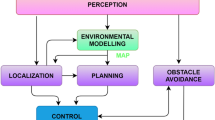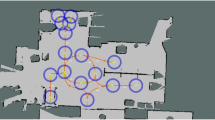Abstract
This paper presents the design and implementation of a real-time solution for the global control of robotic highway safety markers. Problems addressed in the system are: (1) poor scalability and predictability as the number of markers increases, (2) jerky movement of markers, and (3) misidentification of safety markers caused by objects in the environment.
An extensive analysis of the system and two solutions are offered: a basic solution and an enhanced solution. They are built respectively upon two task models: the periodic task model and the variable rate execution (VRE) task model. The former is characterized by four static parameters: phase, period, worst case execution time and relative deadline. The latter has similar parameters, but the parameter values are allowed to change at arbitrary times.
The use of real-time tasks and scheduling techniques solve the first two problems. The third problem is solved using a refined Hough transform algorithm and a horizon scanning window. The approach decreases the time complexity of traditional implementations of the Hough transform with only slightly increased storage requirements.
Similar content being viewed by others
References
Baker, T. P., and Shaw, A. 1988. The cyclic executive model and ada. In Proceedings of Real-Time Systems Symposium, Huntsville, Alabama, pp. 120–129.
Borestein, J., and Koren, Y. 1991. The vector field histogram-fast obstacle avoidance for mobile robots. IEEE Transactions on Robotics and Automation 7(3): 278–288.
Brooks, R. 1986. A robust layered control system for a mobile robot. IEEE Journal of Robotics and Automation 2(1): 14–23.
Devi, U. C. 2003. An improved schedulability test for uniprocessor periodic task systems. In Proceedings of the 15th Euromicro Conference on Real-Time Systems. Porto, Portugal, pp. 23–30.
Dumpert, J. 2004. Hardware and software design for a system of autonomous highway safety markers. M.S. Thesis, Electrical Engineering, University of Nebraska-Lincoln.
Farritor, S., Hacot, H., and Dubowsky, S. 1998. Physics-based planning for planetary exploration. In IEEE International Conference on Robotics and Automation, Vol. 1, Leuven, Belgium, pp. 278–283
Farritor, S. M., and Rentschier, Mark E. 2002. Robotic highway safety markers. In Chris Mellish. (ed.), ASME International Mechanical Engineering Congress and Exposition, Montreal.
Goddard, S. and Jeffay, K. 2001. Managing latency and buffer requirements in processing graph chains. The Computer Journal 44(6): 486–503.
Goddard, S., and Liu, X. 2004. A variable rate execution model. In Proceedings of the 16th Euromicro Conference on Real-Time Systems, Catania, Italy, pp. 135–143.
Jeffay, K., and Goddard, S. 1999. A theory of rate-based execution. In Proceedings of the 20th IEEE Real-Time Systems Symposium, Phoenix, Arizona, pp. 304–314.
Khatib, O. 1986. Real-time obstacle avoidance for manipulators and mobile robots. International Journal of Robotics Research 15(1): 90–98.
Lasky, T. A., and Ravani, B. 2000. Sensor-based path planning and motion control for a robotic system for roadway crack sealing. IEEE Transactions on Control Systems Technology 8(4): 609–622.
Lee, H. M., Kittle, J., and Wong, K. C. 1992. Generalized hough transform in object recognition. In 11th IAPR International Conference vol. 3, pp. 245–289.
Lehoczky, J. P., Sha, L., and Ding, Y. 1989. The rate-monotonic scheduling algorithm: Exact characterization and average case behavior. In Proceedings of Real-Time Systems Symposium, Santa Monica, California, pp. 166-171.
Leung, J. Y. T., and Whitehead, J. 1982. On the complexity of fixed-priority scheduling of periodic, real-time tasks. In Performance Evaluation.
Levine, D. M., Ramsey, P. P., and Smidt, R. K. 2001. Applied Statistics. New Jersey: Prentice Hall.
Liu, J. 2000. Real-Time Systems, New Jersey: Prentice Hall.
Labrosse, J. 2002. The Real Time Kernel MicroC/OS-II. CMP Books.
Liu, C. L., and Layland, J. W. 1973. Scheduling algorithms for multiprogramming in a hard-real-time environment. Journal of the ACM (JACM) 20(1): 46–61.
Mohri, A., Yamamoto, M., and Marushima, S. 1993. Collision-free trajectory planning for two manipulators using virtual coordination space. In IEEE International Conference on Robotics and Automation. Atlanta, Georgia, pp. 674–679.
Mok, A. K. 1983. Fundamental design problems of distributed systems for the hard real-time environment. Ph.D. Thesis, MIT, Department of EE and CS, MIT/LCS/TR-297.
Shah, S. 1996. New work zone safety devices. In Proceedings of the ASCE 3rd International Conference on Applications of Advanced Technologies in Transportation Engineering, pp. 308–315.
Shapiro, L. G. and Stockman, G. C. 2001. Computer Vision, Chapter 10, New Jersey: Prentice Hall.
Shen, X. 2003. Control of robotic highway safety markers. M.S. thesis, Computer Science and Engineering, University of Nebraska-Lincoln.
Sonka, M., Hlavac, V. and Boyle, R. 1998. Image Processing: Analysis and Machine Vision, 2nd edition. London: Chapman & Hall Computing, pp. 679–722.
Velinsky, S. A. 1993. Heavy vehicle system for automated pavement crack sealing. Heavy Vechile Systems, International Journal of Vehicle Design 1(1): 114–128.
White, T. D. 1995. Evolving automation in the asphalt paving industry. TR news, pp. 4–6.
Woo, D. 1995. Robotics in highway construction. Public Roads 58(3): 26–30.
Author information
Authors and Affiliations
Corresponding author
Additional information
Supported, in part, by grants from the National Science Foundation (CCR-0208619 and CNS-0409382) and the National Academy of Sciences Transportation Research Board-NCHRP IDEA Program (Project #90).
Jiazheng Shi received the B.E. and M.E. degrees in electrical engineering from Beijing University of Posts and Telecommunications in 1997 and 2000, respectively. In 2000, he worked with the Global Software Group, Motorola Inc. Currently, he is a Ph.D. candidate in the Computer Science and Engineering Department at the University of Nebraska–Lincoln. His research interests are automated human face recognition, image processing, computer vision, approximate theory, and linear system optimization.
Steve Goddard is a J.D. Edwards Associate Professor in the Department of Computer Science & Engineering at the University of Nebraska–Lincoln. He received the B.A. degree in computer science and mathematics from the University of Minnesota (1985). He received the M.S. and Ph.D. degrees in computer science from the University of North Carolina at Chapel Hill (1995, 1998).
His research interests are embedded, real-time and distributed systems with emphases in high assurance systems engineering and real-time, rate-based scheduling theory.
Anagh Lal received a B.S. degree in Computer Science from the University of Mumbai (Bombay), Mumbai, in 2001. He is currently a graduate research assistant at the University of Nebraska–Lincoln working on a M.S. in Computer Science, and a member of the ConSystLab. His research interests lie in Databases, Constraint Processing and Real Time Systems. Anagh will be graduating soon and is looking for positions at research institutions.
Jason Dumpert received a B.S. degree in electrical engineering from the University of Nebraska–Lincoln in 2001. He received a M.S. degree in electrical engineering from the University of Nebraska-Lincoln in 2004. He is currently a graduate research assistant at the University of Nebraska-Lincoln working on a Ph.D. in biomedical engineering. His research interests include mobile robotics and surgical robotics.
Shane M. Farritor is an Associate Professor in the University of Nebraska–Lincoln’s Department of Mechanical Engineering. His research interests include space robotics, surgical robotics, biomedical sensors, and robotics for highway safety. He holds courtesy appointments in both the Department of Surgery and the Department of Orthopaedic Surgery at the University of Nebraska Medical Center, Omaha. He serves of both the AIAA Space Robotics and Automation technical committee and ASME Dynamic Systems and Control Robotics Panel. He received M.S. and Ph.D. degrees from M.I.T.
Rights and permissions
About this article
Cite this article
Shi, J., Goddard, S., Lal, A. et al. Global Control of Robotic Highway Safety Markers: A Real-time Solution. Real-Time Syst 29, 183–204 (2005). https://doi.org/10.1007/s11241-005-6884-y
Issue Date:
DOI: https://doi.org/10.1007/s11241-005-6884-y




